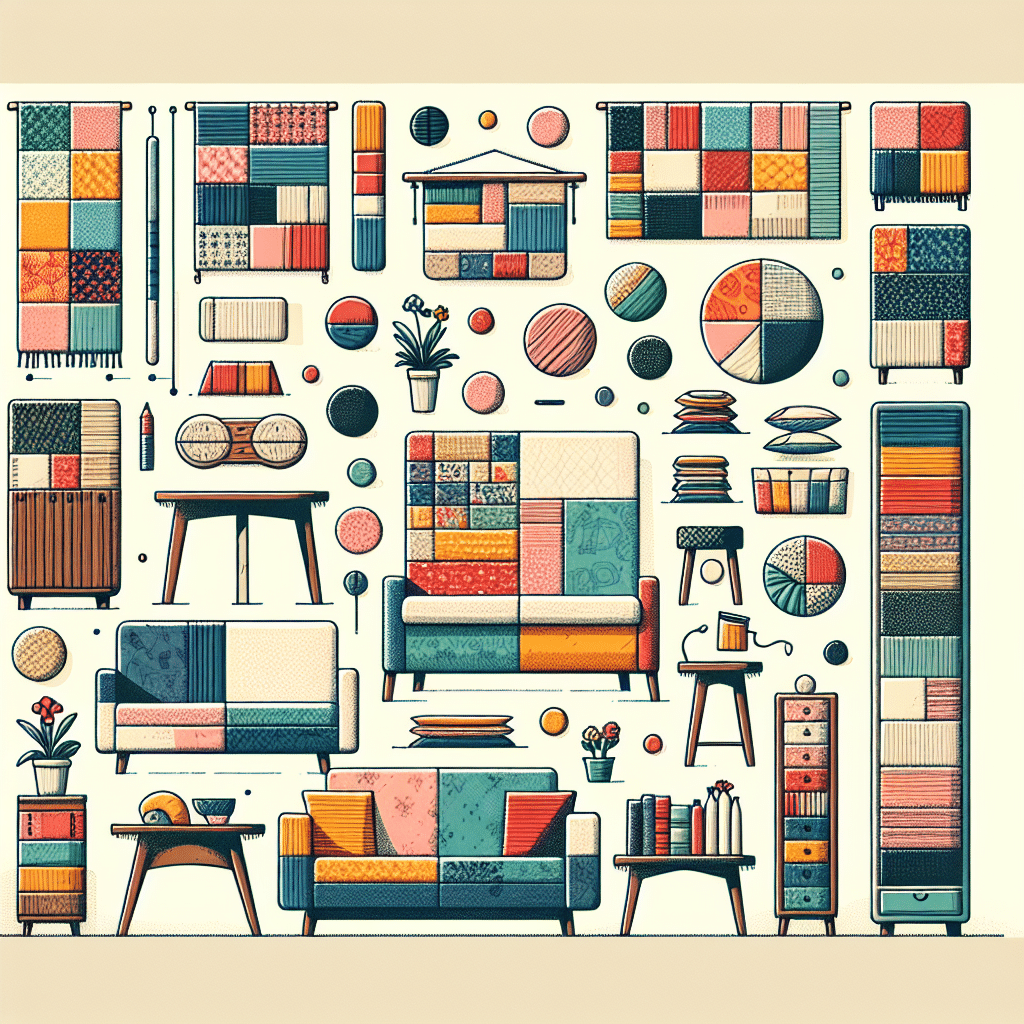Understanding Upcycled Textiles
Upcycling involves transforming waste materials into new products of better quality or environmental value. In the context of textiles, this means reusing fabric scraps, old garments, or linens to create unique furniture pieces. Upcycled textiles not only contribute to sustainability but also bring character and warmth to your home decor.
Selecting the Right Textiles
Assess Fabric Quality
When upcycling textiles, it’s crucial to choose high-quality materials that can withstand wear and tear. Look for fabrics like cotton, denim, canvas, or wool. Avoid fabrics that show signs of heavy wear, fading, or staining that can detract from the aesthetic appeal.
Color and Pattern Coordination
Choose textiles that complement your existing decor. Play with colors, patterns, and textures to create visual interest. If your space is neutral, opt for bold patterns; if your decor is already vibrant, consider more subdued textiles to balance the design.
Furniture Types Ideal for Upcycling
Upholstered Seating
Reupholstering chairs, sofas, and benches with upcycled textiles offers an immediate style upgrade. Use patchwork techniques to combine different fabrics, creating a one-of-a-kind piece. For example, vintage quilts, old curtains, or unused clothes can be transformed into unique upholstery.
Steps for Reupholstering:
- Remove Old Fabric: Carefully unscrew or remove the old fabric from the furniture, taking care to salvage any foam or padding that is in good condition.
- Measure and Cut: Measure the dimensions of the furniture piece and cut your upcycled textiles accordingly, adding a few inches for wrapping.
- Attach the New Fabric: Use a staple gun to affix the new fabric, starting from the center and working outwards to avoid wrinkles.
- Finish Edges: Trim any excess fabric and reattach any hardware that was removed earlier.
Accent Pillows and Cushions
Creating accent pillows from upcycled textiles is one of the simplest projects for beginners. Using old garments or scrap fabric, you can sew pillows that match or contrast your furniture. This small change can dramatically revitalize a living space.
Tips for Pillow Making:
- Coordinate Styles: Use seasonal colors or patterns to change pillows periodically for a fresh look.
- Mix and Match: Experiment with different shapes and sizes to create visual interest on your sofa or bed.
Table Linens
Upcycled textiles can also enhance your dining experience. Transform old tablecloths, napkins, or fabric scraps into table runners or placemats. This not only repurposes materials but also adds a personal touch to your dining area.
Creating a Table Runner:
- Select Your Fabric: Choose an old tablecloth or patchwork fabric that aligns with your style.
- Measure Length and Width: Cut the fabric to your desired dimensions, leaving an extra inch for seam allowance.
- Sew Edges: Finish the edges to prevent fraying by using a sewing machine or iron-on tape.
Creating Unique Furniture Pieces
Upcycled Ottoman
Transforming an old wooden crate or an unused chair into an ottoman can be an exciting DIY project. Use old upholstery fabrics to cover the surface and add foam padding for comfort.
Steps to Create an Ottoman:
- Choose a Base: Select a sturdy wooden crate or a small chair.
- Add Padding: Glue or staple foam padding to the top surface.
- Upholster: Cover the padding with your chosen upcycled fabric, securing it underneath.
- Add Legs (Optional): For a more finished look, consider adding decorative legs or casters.
Fabric-Wrapped Furniture
Another innovative approach is wrapping furniture pieces like side tables or frames in upcycled textiles. This method requires less sewing and can create an impactful visual statement.
Steps to Wrap Furniture:
- Select Your Furniture: Choose small items like side tables or stools.
- Prepare Materials: Gather your upcycled textiles, adhesive, and scissors.
- Cut and Apply: Cut the fabric into strips and apply it with glue, smoothing as you go to avoid wrinkles.
- Seal with Varnish: Finish with a clear varnish for durability, especially if the surface will get regular use.
Adding Finishing Touches
Patchwork Designs
For a more eclectic style, consider patchwork designs where multiple pieces of fabric are sewn together. This method can cover various furniture pieces, from chairs to headboards.
Adding Embellishments
Consider incorporating embellishments like tassels, pom-poms, or buttons made from upcycled materials to accentuate your furniture. This adds an extra layer of uniqueness and creativity.
Maintenance of Upcycled Textiles
Maintaining upcycled textiles requires special care to extend their life. Most upcycled textiles can be machine washed, but always check fabric care labels. For items that have embellishments or delicate fabrics, hand washing is recommended. Regularly vacuum upholstered pieces to remove dust and prevent wear.
Finding Sources for Textiles
Thrift Stores and Flea Markets
Explore local thrift stores, flea markets, or yard sales for unique fabric finds. This can also add a fun treasure-hunting aspect to your DIY project.
Online Marketplaces
Websites like Etsy, eBay, or local marketplace apps often have sellers of vintage or upcycled textiles. Look for reputable sellers to ensure quality materials.
Community Swap Events
Participate in community swap events to exchange unused textiles with others. Not only is this eco-friendly, but it can also foster community spirit.
By incorporating upcycled textiles into your furniture, you create sustainable, personalized spaces that reflect your style and values. The diverse applications from upholstery to decorative accessories ensure endless possibilities while contributing positively to the environment.
